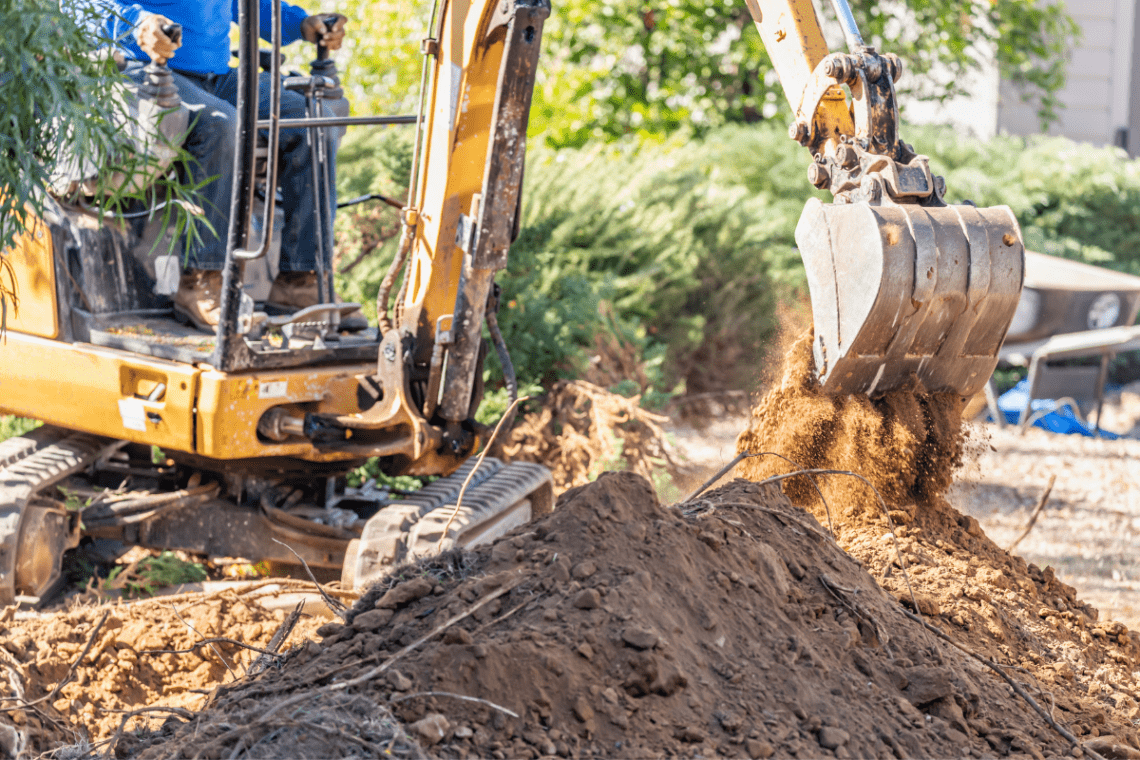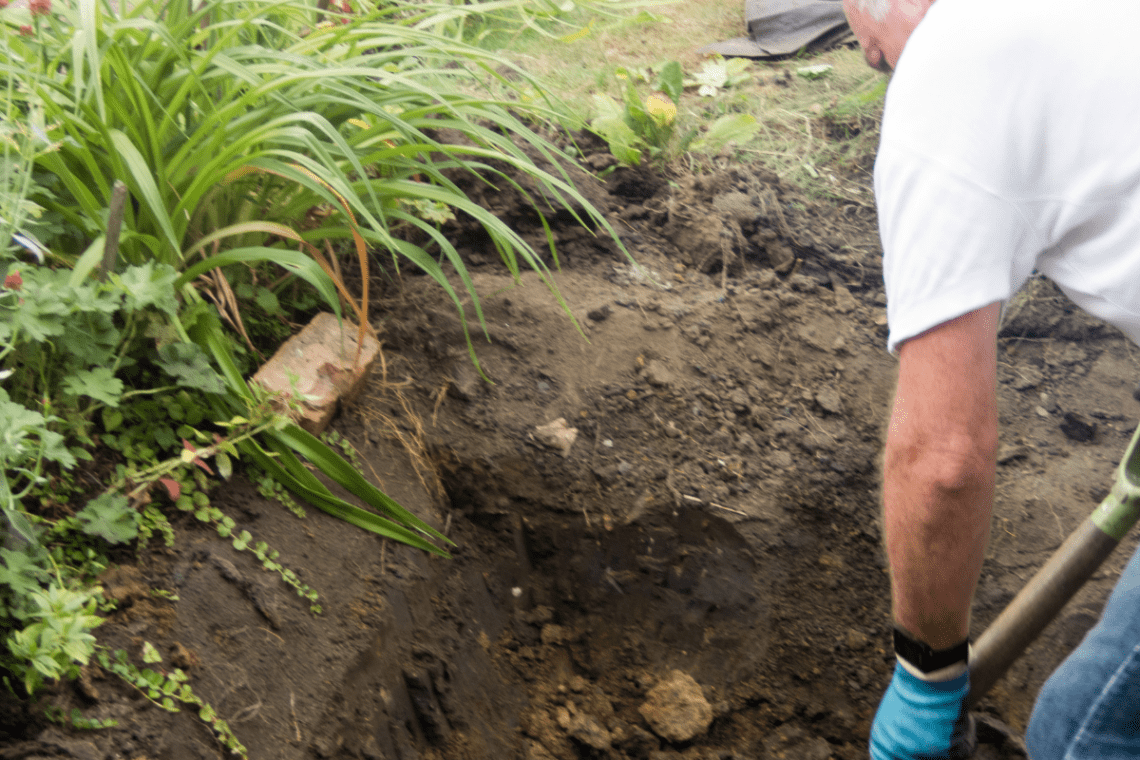When undertaking any excavation project in the UK, it’s crucial to find out whether you require planning permission before digging. This typically depends on the depth and scope of your intended dig, along with its location, such as proximity to buildings or boundaries.
Whether you’re researching how to build a raised pond or want to create a beautiful koi pond, this guide will help you understand the necessary legalities and practical considerations so you can proceed with your project confidently and safely, avoiding any potential headaches along the way.
Key Takeaways
- Verify if your project requires planning permission before beginning to excavate.
- Certain shallow gardening activities might not need a permit.
- Comprehending depth regulations ensures legal compliance and safety.
Understanding Regulations

When undertaking excavation work in the UK, you’re subject to various regulations and restrictions. The National Planning Policy Framework (NPPF) outlines the government’s planning policies and how these are to be applied, particularly with regard to the environment.
Local planning policies may have additional requirements, particularly if your site is within a conservation area, Area of Outstanding Natural Beauty or involves a listed building. It is vital to consult your Local Planning Authority (LPA) to understand specific controls that may affect excavation work.
In the UK, there are prescribed limits to how deep you can dig without requiring a permit, these may vary by location. Always refer to the local council or governing body for exact regulations as these can vary regionally.
For smaller scale excavations, permitted development rights enable you to conduct certain types of work without a full planning application. However, these rights have limitations and are subject to criteria such as depth and volume, and they do not override other legal requirements.
Here’s a brief overview:
- Permitted Development: Generally allows for minor alterations without a permit. However, this does not mean you can dig without constraints.
- Regulations: Can include rules on the maximum depth before a permit is required, which may vary by location.
- Environmental Impact: For more substantial work, a formal assessment may be required to ensure that there is no significant adverse effect on the surroundings.
For specific advice on your project:
- Contact your LPA for guidance related to your site.
- Review your project for any potential impact on a conservation area or listed building.
- Always ensure compliance with the NPPF and local regulations.
Remember, each location may have its own additional rules. It’s your responsibility to adhere to them, or you could face legal repercussions.
Planning Permission and Permitted Development Rights

When undertaking a digging project, understanding planning permission and permitted development rights is crucial in the UK. Planning permission is the formal permission from a local authority for the construction or alteration of buildings and land, which includes digging below a certain depth.
Permitted development rights (PDR), on the other hand, allow you to carry out certain types of work without the need to apply for planning permission. These rights are subject to conditions and limitations to control impact.
Before you dig:
- Check the Planning Portal, an online resource for guidance in the UK.
- Review the technical guidance on householders’ permitted development rights provided by the government.
Here’s what you must note about PDR:
- Householder PDR cover different classes of work, each with specific limitations and conditions.
- You could carry out certain digging activities without a planning application under these rights, but the scope and depth are regulated.
Be aware that:
- Your home’s location, such as a conservation area or listed building status, affects PDR.
- You must comply with building regulations, even if your project falls under PDR.
It is in your best interest to consult the local authority or a professional planner before proceeding with significant digging to ensure you are within legal bounds and to confirm if the scope of your project requires a planning application.
Assessing Risks and Soil Conditions

Before you start any excavation project, conducting a thorough risk assessment is crucial. It’s important to determine the soil type as different soils pose different challenges. Here’s a simple guide to assess risk and soil conditions.
Soil Type and Stability:
- Sandy Soil: This type is granular and tends to collapse easily when dry. Water can also filter through quickly, which can cause instability.
- Clay Soil: Heavier and more stable when dry, but can become extremely slick and malleable when wet.
- High Water Table: Areas with a high water table can greatly increase the risk of excavation collapses due to the additional pressure on excavation walls.
Basic Precautions:
- Identify the type of soil you will be working with.
- Evaluate the presence of a water table near the surface.
- Assess the risk of soil collapse by considering moisture content and expected load on soil walls.
Ground Conditions play a pivotal role in excavation safety. You should be cautious if you encounter:
- Unexpected soil layers.
- Previously disturbed soil.
- Signs of subsurface water.
Ensuring that a risk assessment is completed not only helps in determining if you can dig without a permit but also safeguards against potential dangers when working with challenging ground conditions.
Always take into account mitigating strategies for different soil types and conditions to conduct your work competently and safely. You must always comply with the Health and Safety Executive’s guidelines for safe practice.
Managing Below-ground Hazards and Services

When digging on a property in the UK, it’s critical to be aware of below-ground hazards including buried services, such as cables and pipes. Ensuring the safety of these underground services requires a systematic approach, starting with properly identifying their locations.
Firstly, acquire current service maps and use a cable avoidance tool (CAT) to detect signals from hidden cables. You may need to hand-dig trial pits to confirm the cable location. A formal inspection by a professional should follow. This professional will have the necessary experience to interpret these maps and operate detection equipment effectively.
Keep in mind that groundwater may enter excavations and needs to be properly managed to prevent collapse. Before digging commences:
- Assess the water table level
- Prepare for water management (e.g., pumps)
Remember to continuously consult with utility providers and seek advice from experts to maintain a high safety standard. Always engage with trained personnel to navigate the complex network of underground services while adhering to the best practices.
Why Hiring a Professional is the Safest Choice for Your Excavation Projects

Navigating the intricate landscape of UK excavation regulations, while ensuring the structural integrity and safety of your property, can be a daunting task. This complexity underscores the value of engaging a professional company like Ponds by Michael Wheat for your pond projects.
Here’s why hiring an expert not only saves you time but also guarantees peace of mind:
Expertise in Compliance and Safety
- Planning Permissions: Our team has in-depth knowledge of the UK’s planning permissions and development rights, ensuring that all projects comply with local and national regulations without you needing to wade through the bureaucratic details yourself.
- Building Regulations: Our team ensures that all excavations, regardless of depth, adhere to the strict standards set out by building regulations, safeguarding your project from potential legal issues.
Access to Advanced Equipment and Techniques
From precision excavation tools to heavy-duty machinery, we have state-of-the-art equipment and advanced processes like the Michael Wheat System, that ensures high efficiency and safety.
Hassle-Free Project Execution
By choosing Ponds by Michael Wheat, you’re not just hiring a pond company; you’re ensuring a seamless, hassle-free execution of your project.
From initial consultation to project completion and regular pond maintenance, we handle all aspects and execute the work to the highest standards. This comprehensive service package allows you to focus on your vision, leaving the complexities of logistics to us.
The Ponds by Michael Wheat Advantage
We are committed to delivering high-quality results that not only meet but exceed client expectations, from swimming ponds to wildlife ponds. We prioritise your vision and safety, adapting our strategies to meet your specific needs while ensuring a smooth and hassle-free execution.
Choosing Ponds by Michael Wheat means partnering with a specialist who will navigate the complexities of pond building for you. By entrusting us with your project, you gain peace of mind, knowing that every aspect of the digging process is managed professionally, from initial assessments and legal compliance to the final execution and beautification.
Save yourself the worry of wondering “how deep can I dig without a permit UK” and invest in the safety, legality, and perfection of your landscaping projects. Contact us today for more information or to consult on your next project.
Frequently Asked Questions

1. Can I dig a pond in my garden without obtaining a permit?
Digging a pond can require a permit, especially if the excavation exceeds certain depths or volumes. The specific requirements can vary depending on your local council’s regulations. Always check with your LPA for guidance on whether your specific pond project will require planning permission.
2. Are there specific guidelines for handling archaeological finds during excavation?
If you discover archaeological remains during an excavation, you are required to stop the project and report the finds to your LPA. In areas of archaeological interest, you may need to obtain an archaeological survey before beginning your project. This ensures that any historical artefacts are preserved and protected, which is legally mandatory in designated areas.
3. What are the risks of digging without a permit?
Digging without the necessary permits can lead to legal repercussions, including fines and being required to restore the land to its previous condition. There can also be safety risks if the excavation affects the structural integrity of nearby buildings or underground services.
4. How long does it typically take to get planning permission for an excavation project?
The timeframe for obtaining planning permission can vary significantly depending on the complexity of the project and the local authority’s workload. Typically, a straightforward application might take about eight weeks, while more complex applications could take longer. Early consultation with the LPA can provide a more accurate timeline and help expedite the process.